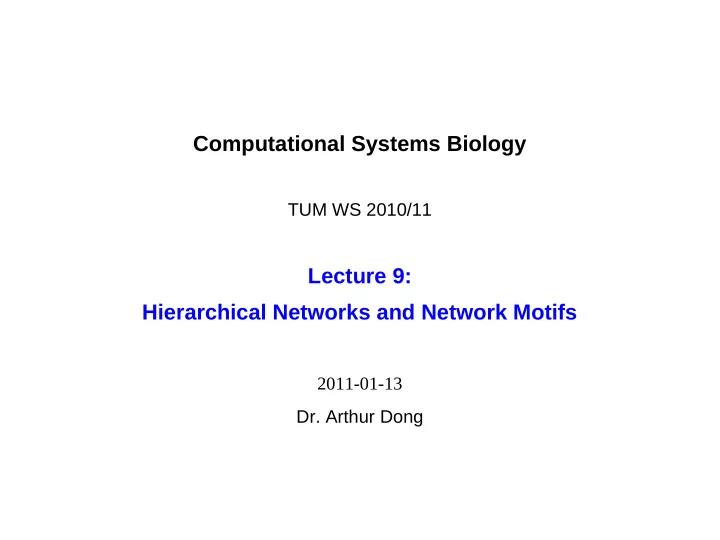

Computational Systems Biology TUM WS 2010/11 Lecture 9: Hierarchical Networks and Network Motifs 2011-01-13 Dr. Arthur Dong
Emergence of Networks Many real-world complex networks Have relatively many hubs → scale-free ➢ Are locally clustered (high CC) ➢ ● CC mostly is independent of system size (number of nodes N) → modular ● CC mostly scales with 1/k (hubs are less clustered) → hierarchical Scale-free and clustering coexist in real networks. Need a model to reconcile those 2 features! Evolution of Models ER (random graph) is the baseline ➢ WS (small-world) focuses on short L (CC just inherited) ➢ BA (scale-free) addresses relative abundance of hubs ➢ Now we need a model to incorporate CC while keeping those other features.
Putting it all together Network Model Construction L CC Hubs Real Evolution short high; N-indep; abundant CC ~ 1/k Random ER Fixed N, uniform p short low; CC ~ 1/N; k- rare indep Small-world WS A little rewiring from short high (inheritance); rare regular graphs N-indep; k-indep Scale-free BA Growth and short high; CC ~ 1/N**0.75; abundant preferential k-indep attachment Hierarchical Fractal Deterministic short high; N-indep; abundant CC ~ 1/k
Deterministic Model (Pseudo-fractal Construction) Hierarchy Dense intra-module connections, sparse inter-module connections Modules get less and less cohesive as level goes up
Deterministic (Fractal) vs probabilistic (BA) scale-free models Like BA, Fractal produces power-law degree distribution. Unlike under BA, under Fractal CC is independent of N and scales with 1/k. The analytics is nontrivial, but you should be able to run numerical simulations!
Explaining the figures What are the points and lines? ➢ What are the appropriate controls? ➢ Like the Fractal model, metabolic networks also exhibit high clustering That is independent of N (modular) ➢ That scales with 1/k (hierarchical) ➢
Network Motifs We have looked at some global features of real complex networks: Short distance between nodes (small-world) ➢ High local clustering (modular) ➢ Abundance of hubs (scale-free) ➢ Much of the advance was propelled by the desire to Explain key features ➢ Reconcile conflicting features ➢ Now we look at “patterns” in complex networks Network motif = small subgraphs that are significantly over-represented Example of a 3-node motif: Do you expect this motif to be over-represented? First focus on directed networks and look at 3- and 4-node motifs What is a 2-node motif? ➢ How many 3-node motifs are there? ➢ How many 4-node motifs are there? ➢ Beware of overcounting due to isomorphisms!
Enumeration of directed 3-node motifs Again, interpretations (what those formalisms actually mean)! Does X ↔ Y make sense in the food web context? Exercise: How many undirected 3-node motifs are there? (8)
Example: Feed-forward loop Count how many times it appears in the real network ➢ Count how many times it appears in “comparable” random networks (through edge- ➢ swapping) Compute empirical p-value or z-score. ➢
Different classes of networks prefer different network motifs
Exercise your common sense How to generalize 3-chain? Do you think it's over- or under-represented? Carnivore → Herbivore → Flora How about feed-forward loop? Incompatibility, omnivore, competition 3-chain Feed-forward loop Wolf Wolf Human Tiger sheep sheep sheep wolf veggie veggie veggie sheep Wolf Tiger sheep rabbit wolf Bi-parallel Feed-back loop veggie sheep
Looking ahead Subnetworks; the effect of sampling and false positives/negatives Effect of sampling on topology predictions of protein-protein interaction networks Nature Biotechnology 23, 839 - 844 (2005) Combining multiple systems (virus-host interactions) Herpesviral Protein Networks and Their Interaction with the Human Proteome Science 13 January 2006, Vol. 311 no. 5758 pp. 239-242 Combining topology with orthogonal data (e.g. mRNA) Evidence for dynamically organized modularity in the yeast protein-protein interaction network Nature 2004 Jul 1;430(6995):88-93 Integrative systems biology (back-and-forth between computation and wet-lab) Integrated Genomic and Proteomic Analyses of a Systematically Perturbed Metabolic Network Science 4 May 2001, Vol. 292 no. 5518 pp. 929-934 Systems Medicine Molecular classification of cancer: class discovery and class prediction by gene expression monitoring Science 1999 Oct 15; 286(5439):531-7 How To Read A Paper
Recommend
More recommend